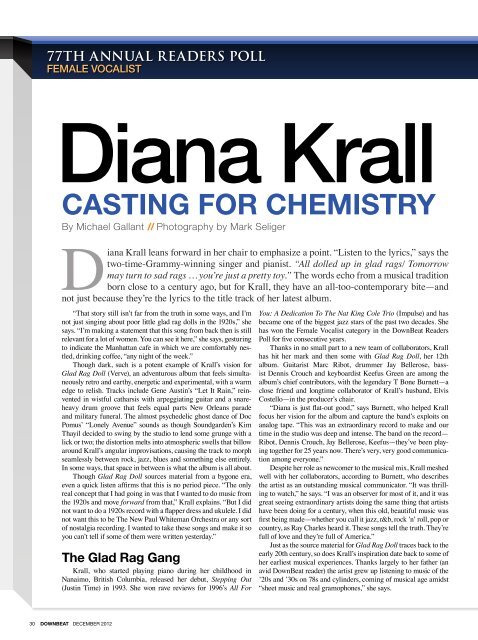Ron Carter Esperanza Spalding - Downbeat
Ron Carter Esperanza Spalding - Downbeat
Ron Carter Esperanza Spalding - Downbeat
You also want an ePaper? Increase the reach of your titles
YUMPU automatically turns print PDFs into web optimized ePapers that Google loves.
77th Annual readers Poll<br />
female vocalist<br />
Diana Krall<br />
Casting for Chemistry<br />
By Michael Gallant // Photography by Mark Seliger<br />
Diana Krall leans forward in her chair to emphasize a point. “Listen to the lyrics,” says the<br />
two-time-Grammy-winning singer and pianist. “All dolled up in glad rags/ Tomorrow<br />
may turn to sad rags … you’re just a pretty toy.” The words echo from a musical tradition<br />
born close to a century ago, but for Krall, they have an all-too-contemporary bite—and<br />
not just because they’re the lyrics to the title track of her latest album.<br />
“That story still isn’t far from the truth in some ways, and I’m<br />
not just singing about poor little glad rag dolls in the 1920s,” she<br />
says. “I’m making a statement that this song from back then is still<br />
relevant for a lot of women. You can see it here,” she says, gesturing<br />
to indicate the Manhattan cafe in which we are comfortably nestled,<br />
drinking coffee, “any night of the week.”<br />
Though dark, such is a potent example of Krall’s vision for<br />
Glad Rag Doll (Verve), an adventurous album that feels simultaneously<br />
retro and earthy, energetic and experimental, with a warm<br />
edge to relish. Tracks include Gene Austin’s “Let It Rain,” reinvented<br />
in wistful catharsis with arpeggiating guitar and a snareheavy<br />
drum groove that feels equal parts New Orleans parade<br />
and military funeral. The almost psychedelic ghost dance of Doc<br />
Pomus’ “Lonely Avenue” sounds as though Soundgarden’s Kim<br />
Thayil decided to swing by the studio to lend some grunge with a<br />
lick or two; the distortion melts into atmospheric swells that billow<br />
around Krall’s angular improvisations, causing the track to morph<br />
seamlessly between rock, jazz, blues and something else entirely.<br />
In some ways, that space in between is what the album is all about.<br />
Though Glad Rag Doll sources material from a bygone era,<br />
even a quick listen affirms that this is no period piece. “The only<br />
real concept that I had going in was that I wanted to do music from<br />
the 1920s and move forward from that,” Krall explains. “But I did<br />
not want to do a 1920s record with a flapper dress and ukulele. I did<br />
not want this to be The New Paul Whiteman Orchestra or any sort<br />
of nostalgia recording. I wanted to take these songs and make it so<br />
you can’t tell if some of them were written yesterday.”<br />
The Glad Rag Gang<br />
Krall, who started playing piano during her childhood in<br />
Nanaimo, British Columbia, released her debut, Stepping Out<br />
(Justin Time) in 1993. She won rave reviews for 1996’s All For<br />
You: A Dedication To The Nat King Cole Trio (Impulse) and has<br />
became one of the biggest jazz stars of the past two decades. She<br />
has won the Female Vocalist category in the DownBeat Readers<br />
Poll for five consecutive years.<br />
Thanks in no small part to a new team of collaborators, Krall<br />
has hit her mark and then some with Glad Rag Doll, her 12th<br />
album. Guitarist Marc Ribot, drummer Jay Bellerose, bassist<br />
Dennis Crouch and keyboardist Keefus Green are among the<br />
album’s chief contributors, with the legendary T Bone Burnett—a<br />
close friend and longtime collaborator of Krall’s husband, Elvis<br />
Costello—in the producer’s chair.<br />
“Diana is just flat-out good,” says Burnett, who helped Krall<br />
focus her vision for the album and capture the band’s exploits on<br />
analog tape. “This was an extraordinary record to make and our<br />
time in the studio was deep and intense. The band on the record—<br />
Ribot, Dennis Crouch, Jay Bellerose, Keefus—they’ve been playing<br />
together for 25 years now. There’s very, very good communication<br />
among everyone.”<br />
Despite her role as newcomer to the musical mix, Krall meshed<br />
well with her collaborators, according to Burnett, who describes<br />
the artist as an outstanding musical communicator. “It was thrilling<br />
to watch,” he says. “I was an observer for most of it, and it was<br />
great seeing extraordinary artists doing the same thing that artists<br />
have been doing for a century, when this old, beautiful music was<br />
first being made—whether you call it jazz, r&b, rock ’n’ roll, pop or<br />
country, as Ray Charles heard it. These songs tell the truth. They’re<br />
full of love and they’re full of America.”<br />
Just as the source material for Glad Rag Doll traces back to the<br />
early 20th century, so does Krall’s inspiration date back to some of<br />
her earliest musical experiences. Thanks largely to her father (an<br />
avid DownBeat reader) the artist grew up listening to music of the<br />
’20s and ’30s on 78s and cylinders, coming of musical age amidst<br />
“sheet music and real gramophones,” she says.<br />
30 DOWNBEAT DECEMBER 2012
















